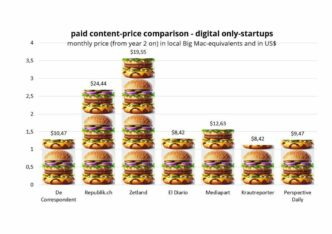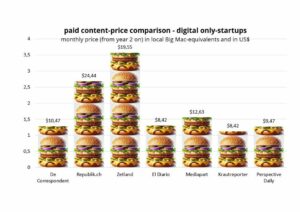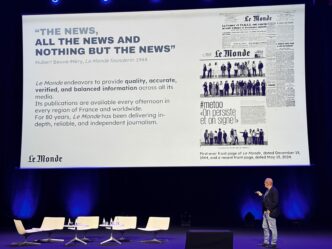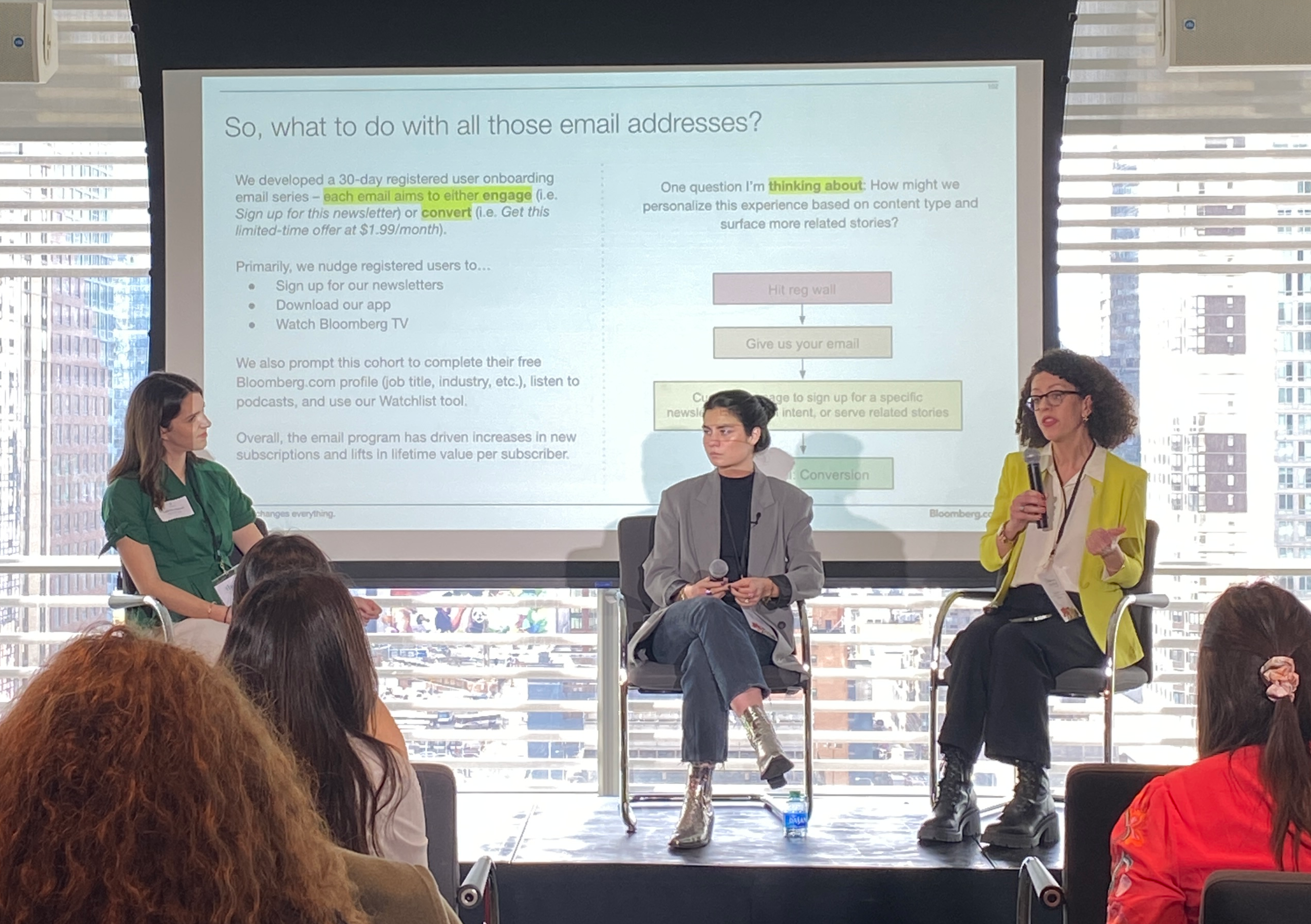

The Audiencers' Festival at The New York Times Building on March 15th brought together 150 digital publishing professionals to discuss everything from audience research to newsletters, engaging young audiences and (you guessed it) maximizing on the value of registration. In this registration session, our panelists dove into how you can use registration to serve your subscription model, how to use data to better acquire registered users and the value of registration for lifetime value. Our speakers: - Megan Hess, Senior Editor, Digital Subscriptions (Bloomberg) - Marion Collombat, Head of CRM & DATA (Reworld Media) - Ludivine Paquet, Head of Customer Success (Poool)
In the last 10 months, we’ve seen some pretty major shifts in the ecosystem. Social traffic is dropping, with Facebook and X de-prioritizing news. Google’s changes in algorithms and cookies, not to mention privacy legislations and AI… So while you can’t ignore the platforms and the size and scope that they offer, all these developments have created a shift, encouraging publishers to think more about on-site engagement, first-party data, known audiences and paying subscribers.
Registration is essential here, especially for readers who aren’t yet engaged. They don’t see the value in subscription right away, so the goal should instead be to hook them in, and show them the breadth and depth of what your publication can offer, developing habits that will help them to subscribe. Without this strategy, by simply hard-walling everything, there’s no ‘hook’. Especially for people who came through Instagram, YouTube, or other social platforms.
Bloomberg: registration to serve a subscription model
Since 2018, Bloomberg has had a dynamic metered paywall. But in 2022, they introduced registration, mainly for new users. By sharing their email address, readers create a Bloomberg profile and are allowed access to more content before hitting the paywall.
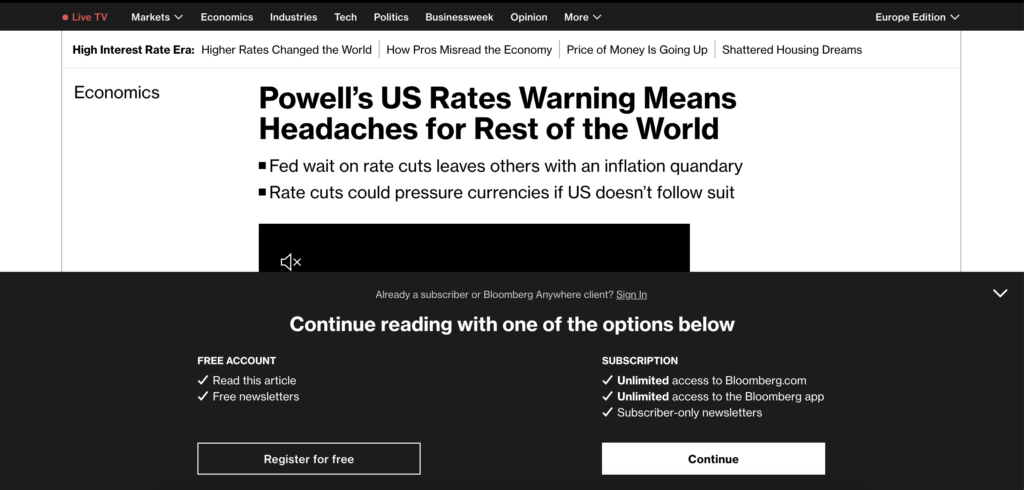
The team is experimenting with this split reg wall / paywall that allows you to either register to read the article for free, or to subscribe. This shows readers clearly what you get as a paying subscriber.
Journeys are also adapted based on source of traffic. For instance, readers coming from Reddit will see a soft-registration wall, offering 5 articles for free within 30 days of registering to increase engagement & introduce these readers to the brand.
Editorial experimentation
Bloomberg shows the reg wall programmatically to most new users, but they’re also using it to experiment on stories with high consumer value that have the capacity to travel far and capture audiences that are likely to come back.
Conversion strategies also depend on the content itself. For instance, the paywall is removed from some coverage during key news moments, such as Bloomberg Green stories during COP, which were placed behind a reg wall instead of the paywall.
We’re using registration to grow audience and visibility around some of our global election coverage this year because politics is such a highly commoditized space.”
> You’ll also enjoy: Registration wall: benchmarking publishers’ account creation journey
What does Bloomberg do with all these email addresses?
“We developed a 30-day registered user onboarding email series – each email aims to either engage (i.e. Sign up for this newsletter) or convert (i.e. Get this limited-time offer at $1.99/month).”
Users are nudged to sign up for a newsletter, download the app and watch Bloomberg TV, things that the team knows are associated with a higher propensity to subscribe, or behaviors that paying subscribers possess. They’re also prompted to complete their free Bloomberg.com profile (job title, industry, etc.), listen to podcasts, and use the Watchlist tool. And, importantly, registration means the ability to show readers the value of a subscription, instead of just telling them.
“On an offer page, you’d say what the value is. But if we can get a reader to sign up for a newsletter that will land in their inbox every day, or listen to a podcast that becomes part of their life, they can actually experience the value, and why it’s worth paying, versus just some words on a page. Overall, the email program has driven increases in new subscriptions and lifts in lifetime value per subscriber.”
Bloomberg is also using registration data to personalize the new Bloomberg.com homepage – “Good morning/afternoon/evening, Megan” greets the reader as an entry point to quickly digest what they need to know at any point in the day, including recommended newsletters and podcasts based on consumption habits.
Reworld Media: using data to better engage and to increase your logged user base
Crossing the Atlantic, Marion Collombat, Head of CRM and data, shared how Reworld Media, with their 80+ brands in France, is putting audience data to work following registration.
Thanks to such a wide variety of verticals, data can be collected and put to use from each brand. But also across brands to inform Reworlds overall strategy, increase reader engagement, move readers to discover new brands and convince them to subscribe.
Beauté Test: A community of 350K beauty enthusiasts
Beauté Test, for example, is one of Reworld’s brands launched in 2003. The digital publication is a beauty product testing and reviewing site, with a community-based business model, monetizing through product testing and data collection.
One of the key goals for Beauté Test in 2024 is to increase their logged user base, both on-site and on social media. These readers can share their opinion on a product, chat in the forum, discover the best products for their skin and hair, and participate in consumer panels.
For Beauté Test, these logged users are essential for their community-based business model thanks to first-party data collection, for product testing, their retail media brands and CRM. For instance, the team has built an infrastructure between their CRM and DMP to know if a user has been on a certain page, what their email is, etc. so as to retarget from this 1st party data, without the need for 3rd party cookies.
How are Reworld increasing their logged user base?
- Identify future logged users through consent consumption behavior
Sharing data across Reworld Media brands, they can see if a user comments on a specific product and target adapted campaigns.
2. Collect data to target – content is the basis of everything
Reworld have over 1200 user cohorts plugged on all websites, based on what a user has seen and interacted with, which can then inform content decisions, both in terms of creating the right content, but also sharing the right content with the right person, across different assets – CRM, app, forum, etc.
For example, for CRM campaigns, they have created 50 user cohorts from the DMP with different newsletter and banner personalization to target each user and encourage them to convert into a logged member.
This type of targeting also has a positive impact on other KPIs across these assets. For instance, newsletter open and click rates that are significantly higher when data is put to use in personalizing the user experience.
> To add to your reading list: How La langue française increased registered user acquisition by 450% thanks to a “bittersweet” strategy
Registration to increase lifetime value
Ludivine Paquet, Head of Customer Success at Poool, also shared how there’s increasingly more proof that registration is not only valuable for increasing conversion rates to subscription, but also for lifetime value.
In the panel, Ludivine gave the example of the French publisher, Alternatives Économiques. They originally had a 2 step user journey where all audiences were asked to create a free account before being blocked by the paywall. This was valuable for collecting data, increasing engagement and propensity to subscribe in the future. However, the team wondered how they could improve overall conversion rates and be more dynamic in their approach.
To test this theory out, they tried blocking “high propensity to subscribe” content with a paywall directly, keeping their 2-step journey on “other content”.
The A/B test was run for 6 months, and results were clear. Blocking high propensity to subscribe content with a paywall on the first article led to fewer registrations, but significantly more subscriptions (with a ratio of 1:3 unlocked article, a 3.5 times higher CR) and 2.5 times higher immediate revenue (24 month LTV).
But the team wanted to investigate the business value of this strategy further. So they decided to measure the revenue of each user journey after 8 months, finding that the balance changed. The 2-step user journey, with registration as a first conversion step, brought a higher lifetime value (€480) compared to blocking with a paywall alone (€420 24 months LTV). Upon analyzing the reasons for this, Alternatives Economiques found that it was thanks to higher engagement amongst these registered users, more frequent return visits and better retention once these users subscribed.



